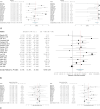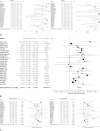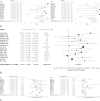Diagnostic accuracy of ultrasound in the diagnosis of Placenta accreta spectrum: systematic review and meta-analysis
- PMID: 37189095
- PMCID: PMC10186814
- DOI: 10.1186/s12884-023-05675-6
Diagnostic accuracy of ultrasound in the diagnosis of Placenta accreta spectrum: systematic review and meta-analysis
Abstract
Objective: To evaluate the diagnostic accuracy of ultrasound and in the diagnosis of Placenta accreta spectrum (PAS).
Data sources: Screening of MEDLINE, CENTRAL, other bases from inception to February 2022 using the keywords related to placenta accreta, increta, percreta, morbidly adherent placenta, and preoperative ultrasound diagnosis.
Study eligibility criteria: All available studies- whether were prospective or retrospective- including cohort, case control and cross sectional that involved prenatal diagnosis of PAS using 2D or 3D ultrasound with subsequent pathological confirmation postnatal were included. Fifty-four studies included 5307 women fulfilled the inclusion criteria, PAS was confirmed in 2025 of them.
Study appraisal and synthesis methods: Extracted data included settings of the study, study type, sample size, participants characteristics and their inclusion and exclusion criteria, Type and site of placenta previa, Type and timing of imaging technique (2D, and 3D), severity of PAS, sensitivity and specificity of individual ultrasound criteria and overall sensitivity and specificity.
Results: The overall sensitivity was 0.8703, specificity was 0.8634 with -0.2348 negative correlation between them. The estimate of Odd ratio, negative likelihood ratio and positive likelihood ratio were 34.225, 0.155 and 4.990 respectively. The overall estimates of loss of retroplacental clear zone sensitivity and specificity were 0.820 and 0.898 respectively with 0.129 negative correlation. The overall estimates of myometrial thinning, loss of retroplacental clear zone, the presence of bridging vessels, placental lacunae, bladder wall interruption, exophytic mass, and uterovesical hypervascularity sensitivities were 0.763, 0.780, 0.659, 0.785, 0.455, 0.218 and 0.513 while specificities were 0.890, 0.884, 0.928, 0.809, 0.975, 0.865 and 0.994 respectively.
Conclusions: The accuracy of ultrasound in diagnosis of PAS among women with low lying or placenta previa with previous cesarean section scars is high and recommended in all suspected cases.
Trial registration: Number CRD42021267501.
Keywords: Morbidly adherent placenta; Placenta accreta; Placenta accreta spectrum; Placenta increta; Placenta percreta; Prenatal ultrasound diagnosis.
© 2023. The Author(s).
Conflict of interest statement
All authors reported No conflict of interest.
Figures











Similar articles
-
Prospective evaluation of impact of post-Cesarean section uterine scarring in perinatal diagnosis of placenta accreta spectrum disorder.Ultrasound Obstet Gynecol. 2022 Apr;59(4):474-482. doi: 10.1002/uog.23732. Epub 2022 Mar 8. Ultrasound Obstet Gynecol. 2022. PMID: 34225385 Free PMC article.
-
Third-trimester ultrasound for antenatal diagnosis of placenta accreta spectrum in women with placenta previa: results from the ADoPAD study.Ultrasound Obstet Gynecol. 2022 Sep;60(3):381-389. doi: 10.1002/uog.24889. Ultrasound Obstet Gynecol. 2022. PMID: 35247287 Free PMC article.
-
Effectiveness of Ultrasound Screening for a Placenta Accreta Spectrum Using Standard Ultrasound Criteria in a Secondary Care Setting.Fetal Diagn Ther. 2022;49(1-2):52-59. doi: 10.1159/000521738. Epub 2022 Jan 11. Fetal Diagn Ther. 2022. PMID: 35016178
-
Diagnostic accuracy of ultrasound in detecting the severity of abnormally invasive placentation: a systematic review and meta-analysis.Acta Obstet Gynecol Scand. 2018 Jan;97(1):25-37. doi: 10.1111/aogs.13238. Epub 2017 Nov 28. Acta Obstet Gynecol Scand. 2018. PMID: 28963728
-
Modified Delphi study of ultrasound signs associated with placenta accreta spectrum.Ultrasound Obstet Gynecol. 2023 Apr;61(4):518-525. doi: 10.1002/uog.26155. Ultrasound Obstet Gynecol. 2023. PMID: 36609827
Cited by
-
Machine learning applications in placenta accreta spectrum disorders.Eur J Obstet Gynecol Reprod Biol X. 2024 Dec 24;25:100362. doi: 10.1016/j.eurox.2024.100362. eCollection 2025 Mar. Eur J Obstet Gynecol Reprod Biol X. 2024. PMID: 39845985 Free PMC article. Review.
-
Prediction of bleeding in placenta accrete spectrum with lacunar surface: a novel aspect.J Ultrasound. 2024 Jun;27(2):375-382. doi: 10.1007/s40477-024-00878-9. Epub 2024 Mar 29. J Ultrasound. 2024. PMID: 38551780 Free PMC article.
-
Engineering nanosystems for regulating reproductive health in women.Theranostics. 2025 Jan 1;15(2):439-459. doi: 10.7150/thno.102626. eCollection 2025. Theranostics. 2025. PMID: 39744682 Free PMC article. Review.
-
Additional Role of Magnetic Resonance Imaging to Ultrasound in Assessing Placenta Accreta Spectrum Disorders: A Retrospective Cross-sectional Study from Vietnam.Oman Med J. 2024 Nov 30;39(6):e697. doi: 10.5001/omj.2024.119. eCollection 2024 Nov. Oman Med J. 2024. PMID: 40260287 Free PMC article.
-
Accuracy of MRI-Based Radiomics in Diagnosis of Placenta Accreta Spectrum: A PRISMA Systematic Review and Meta-Analysis.Med Sci Monit. 2024 Mar 15;30:e943461. doi: 10.12659/MSM.943461. Med Sci Monit. 2024. PMID: 38486373 Free PMC article.
References
Publication types
MeSH terms
LinkOut - more resources
Full Text Sources

